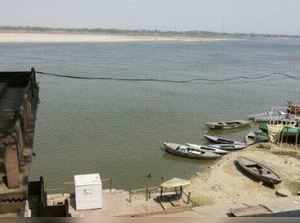
VARANASI: The Rs 20,000-crore “Namami Gange” project to “conserve, clean and rejuvenate” the Ganga river seems to have failed to achieve its target. On the contrary, analysis of data collected by the city-based Sankat Mochan Foundation (SMF) has revealed a significant rise in coliform bacteria and biochemical oxygen demand (BOD), important parameters to evaluate water quality.
Prime Minister Narendra Modi had set an ambitious 2019 deadline to achieve results on nirmalta (cleanliness) of Ganga when he launched the project in May 2015. Union minister Nitin Gadkari last year extended the deadline to March 2020.
SMF, a Varanasi-based NGO, has been monitoring the quality of Ganga water since the launch of the Ganga Action Plan by then Prime Minister Rajiv Gandhi in 1986. Working as a watchdog for the cause of the Ganga, SMF has established its own laboratory to analyse the samples of Ganga water on a regular basis.
Coliform in Ganga water at alarming levels
Lok Sabha Elections#Elections With
Data collected by SMF’s Ganga Laboratory at Tulsi Ghat here has painted a gloomy picture of the Ganga’s health due to high bacterial pollution. Coliform organisms should be 50MPN (most probable number)/100ml or less in drinking water and 500MPN/100ml in outdoor bathing water, while BOD should be less than 3mg/l. According to SMF data, faecal coliform count rose from 4.5 lakh (upstream at Nagwa) and 5.2 crore (downstream in Varuna) in January 2016 to 3.8 crore (upstream) and 14.4 crore (downstream) in February 2019.
“Similarly, BOD level has risen from 46.8-54mg/l to 66-78mg/l during January 2016-February 2019. Besides, the level of dissolved oxygen (DO), which should be 6mg/l or more, has gone down from 2.4mg/l to 1.4mg/l during this period. High presence of coliform bacteria in Ganga water is alarming for human health,” said SMF president and IIT-BHU professor V N Mishra, who is also the mahant of the famous Sankat Mochan temple.
“Faecal coliform is present in the gut and faeces of warmblooded animals. Consequently, E coli is considered to be the species of coliform bacteria that is the best indicator of faecal pollution and possible presence of disease-causing pathogens,” said noted environmental scientist and former BHU professor B D Tripathi.
A slight improvement was seen in tapping discharge of sewage into the Ganga during this period.
Prime Minister Narendra Modi had set an ambitious 2019 deadline to achieve results on nirmalta (cleanliness) of Ganga when he launched the project in May 2015. Union minister Nitin Gadkari last year extended the deadline to March 2020.
SMF, a Varanasi-based NGO, has been monitoring the quality of Ganga water since the launch of the Ganga Action Plan by then Prime Minister Rajiv Gandhi in 1986. Working as a watchdog for the cause of the Ganga, SMF has established its own laboratory to analyse the samples of Ganga water on a regular basis.
Coliform in Ganga water at alarming levels
Lok Sabha Elections#Elections With 
- All
- Uttar Pradesh
- Maharashtra
- Tamil Nadu
- West Bengal
- Bihar
- Karnataka
- Andhra Pradesh
- Telangana
- Kerala
- Madhya Pradesh
- Rajasthan
- Delhi
- Other States
“Similarly, BOD level has risen from 46.8-54mg/l to 66-78mg/l during January 2016-February 2019. Besides, the level of dissolved oxygen (DO), which should be 6mg/l or more, has gone down from 2.4mg/l to 1.4mg/l during this period. High presence of coliform bacteria in Ganga water is alarming for human health,” said SMF president and IIT-BHU professor V N Mishra, who is also the mahant of the famous Sankat Mochan temple.
“Faecal coliform is present in the gut and faeces of warmblooded animals. Consequently, E coli is considered to be the species of coliform bacteria that is the best indicator of faecal pollution and possible presence of disease-causing pathogens,” said noted environmental scientist and former BHU professor B D Tripathi.
A slight improvement was seen in tapping discharge of sewage into the Ganga during this period.
(Catch all the Business News, Breaking News, Budget 2024 News, Budget 2024 Live Coverage, Events and Latest News Updates on The Economic Times.)
...moreDownload The Economic Times News App to get Daily Market Updates & Live Business News.
Subscribe to The Economic Times Prime and read the ET ePaper online.
Read More News on
(Catch all the Business News, Breaking News, Budget 2024 News, Budget 2024 Live Coverage, Events and Latest News Updates on The Economic Times.)
...moreDownload The Economic Times News App to get Daily Market Updates & Live Business News.
Subscribe to The Economic Times Prime and read the ET ePaper online.










